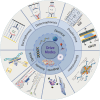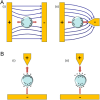Microfluidic-based electrically driven particle manipulation techniques for biomedical applications
- PMID: 39758908
- PMCID: PMC11697266
- DOI: 10.1039/d4ra05571c
Microfluidic-based electrically driven particle manipulation techniques for biomedical applications
Abstract
Microfluidic chips exhibit unique advantages in both economy and rapidity, particularly for the separation and detection of biomolecules. In this review, we first introduced the mechanisms of several electrically driven methods, such as electrophoresis, dielectrophoresis, electro-wetting and electro-rotation. We then discussed in detail the application of these methods in nucleic acid analysis, protein manipulation and cell treatment. In addition, we outlined the considerations for material selection, manufacturing processes and structural design of microfluidic chips based on electrically driven mechanisms.
This journal is © The Royal Society of Chemistry.
Conflict of interest statement
The authors declare no competing interests.
Figures
















Similar articles
-
Signal-Based Methods in Dielectrophoresis for Cell and Particle Separation.Biosensors (Basel). 2022 Jul 11;12(7):510. doi: 10.3390/bios12070510. Biosensors (Basel). 2022. PMID: 35884313 Free PMC article. Review.
-
Recent Advances in Dielectrophoretic Manipulation and Separation of Microparticles and Biological Cells.Biosensors (Basel). 2024 Aug 27;14(9):417. doi: 10.3390/bios14090417. Biosensors (Basel). 2024. PMID: 39329792 Free PMC article. Review.
-
Biomedical Applications of Microfluidic Devices: A Review.Biosensors (Basel). 2022 Nov 16;12(11):1023. doi: 10.3390/bios12111023. Biosensors (Basel). 2022. PMID: 36421141 Free PMC article. Review.
-
A review of active and passive hybrid systems based on Dielectrophoresis for the manipulation of microparticles.J Chromatogr A. 2022 Aug 2;1676:463268. doi: 10.1016/j.chroma.2022.463268. Epub 2022 Jun 21. J Chromatogr A. 2022. PMID: 35779391 Review.
-
Microfluidic chip electrophoresis for biochemical analysis.J Sep Sci. 2020 Jan;43(1):258-270. doi: 10.1002/jssc.201900758. Epub 2019 Nov 12. J Sep Sci. 2020. PMID: 31654552 Review.
References
-
- Jiang J. Cui X. Huang Y. Yan D. Wang B. Yang Z. Chen M. Wang J. Zhang Y. Liu G. Advances and Prospects in Integrated Nano-oncology. Nano Biomed. Eng. 2024;16(2):152–187.
-
- Tian Q. Mu Y. Xu Y. Song Q. Yu B. Ma C. Jin W. Jin Q. An integrated microfluidic system for bovine DNA purification and digital PCR detection. Anal. Biochem. 2015;491:55–57. - PubMed
-
- Chen M. Lin S. Zhou C. Cui D. Haick H. Tang N. From conventional to microfluidic: progress in extracellular vesicle separation and individual characterization. Adv. Healthcare Mater. 2023;12(8):2202437. - PubMed
-
- Yatsushiro S. Yamaguchi Y. Yamamura S. Shinohara Y. Baba Y. Kataoka M. Highly sensitive DNA detection with a combination of 2 DNA-intercalating dyes for microchip electrophoresis. J. Pharm. Biomed. Anal. 2011;55(1):202–205. - PubMed
-
- Qian J.-J. Ji H.-Y. Cong H. Wang H.-M. Jin Q.-H. Application of Polydimethylsiloxane/Glass Microchips for Fast Electrophoretic Separation of Serum High-density Lipoprotein Subclasses. Chin. J. Anal. Chem. 2012;40(2):230–235.
Publication types
LinkOut - more resources
Full Text Sources

